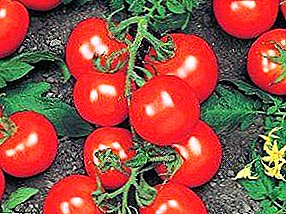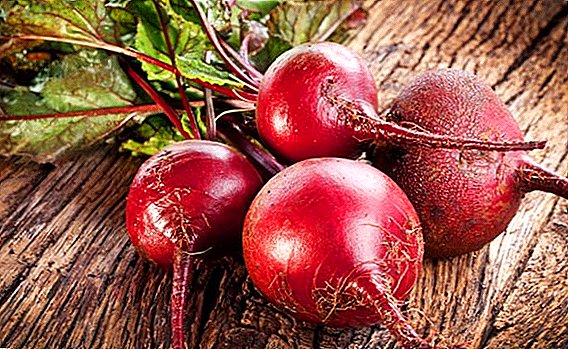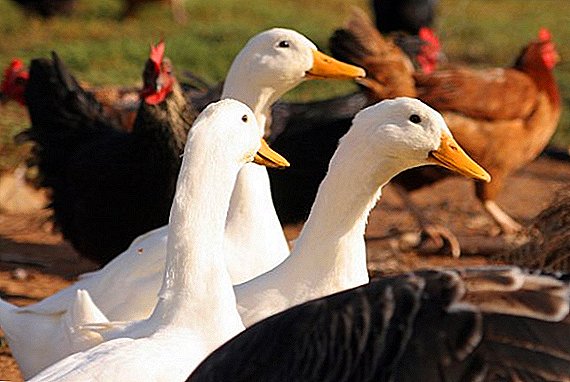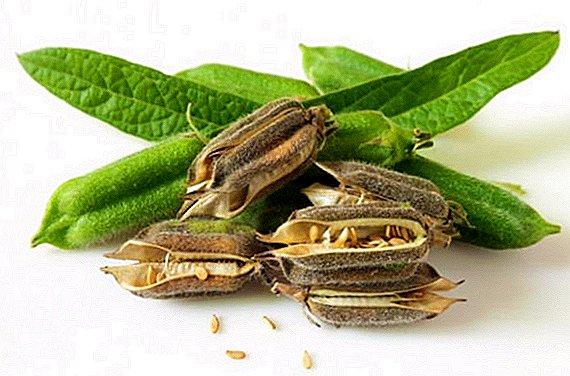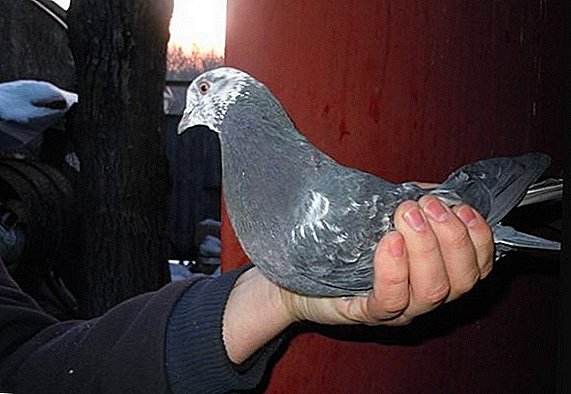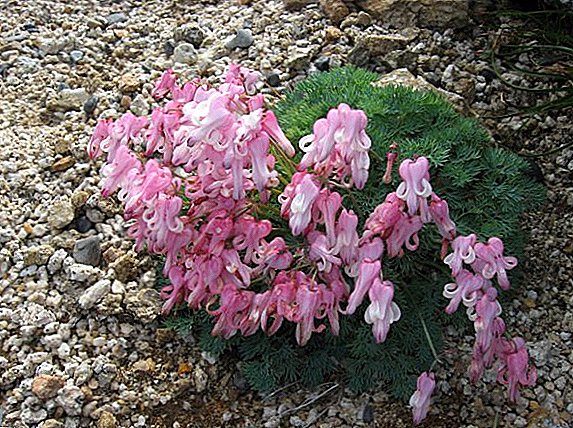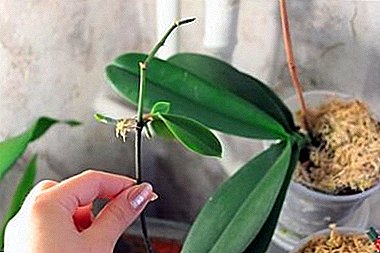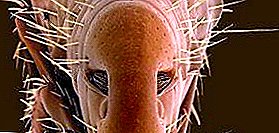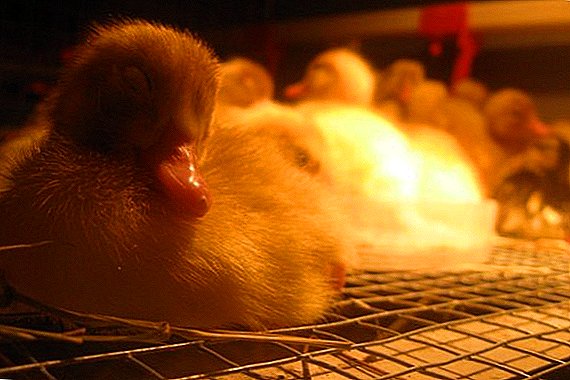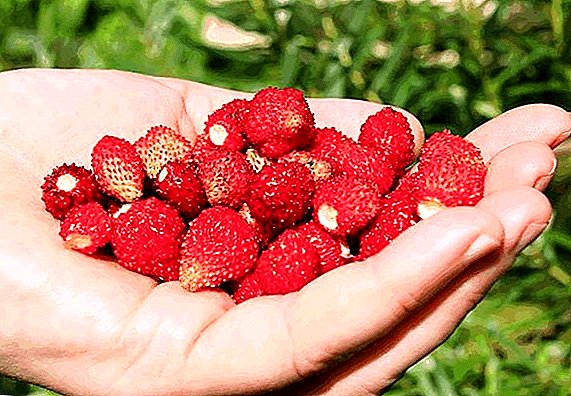 Almost the entire population of the globe, from young to old, loves large and fragrant strawberries, which are often mistakenly called strawberries by the people. Every year, gardeners are looking for new crop varieties of strawberries to successfully update their degenerate strawberry plantations. One of the fruitful varieties of strawberry repair is the Cinderella variety. How to plant a Cinderella on your plot, how to propagate this variety with a mustache or grow from seeds, protect against diseases and eventually obtain perennial abundant harvests of berries - all this will be discussed in detail in this article.
Almost the entire population of the globe, from young to old, loves large and fragrant strawberries, which are often mistakenly called strawberries by the people. Every year, gardeners are looking for new crop varieties of strawberries to successfully update their degenerate strawberry plantations. One of the fruitful varieties of strawberry repair is the Cinderella variety. How to plant a Cinderella on your plot, how to propagate this variety with a mustache or grow from seeds, protect against diseases and eventually obtain perennial abundant harvests of berries - all this will be discussed in detail in this article.
Description and characteristics of the variety
The variety of strawberries "Cinderella" was obtained by Russian breeders as a result of selection work with two varieties of garden strawberries - "Festival" and "Zeng-Zengana". The new variety has incorporated the best parental traits. 
Description strawberry variety "Cinderella":
- bush vigorous, but not sprawling;
- ripens quite late;
- leaves are large, with a dark green color;
- inflorescences are low (flush with the leaves or slightly lower);
- peduncles dense and thick, well holding berries;
- berry shape - classic, gently rounded;
- the average weight of a berry is up to 20 g (the weight of the first berries is twice as large);
- sweet taste, sweet and sour;
- the flesh of the berries is red-orange in color, not loose, well transported;
- flowers are large, with five white petals;
- maternal bush gives little sockets (mustache).
Did you know? Unlike other berries, strawberry seeds are not hidden in the berry pulp, but are located on the surface. On the skin of each strawberry is almost two hundred seeds.

Features and differences from other varieties
Judging by the description of other strawberry varieties - strawberry "Cinderella" is different from the others for the better. The beauty of the berries, she asks on the photo cover of gardening magazines. She has delicious, with shiny sides berries, which have a pronounced strawberry flavor and a very harmonious taste.
Very convenient for summer residents and the fact that This variety gives little growth of strawberry mustache.. After all, some varieties are so spread across the plot that the gardener has to weed out their growth until late autumn.
Learn how to grow other varieties of strawberries: "Alba", "Ali Baba", "Victoria".
But its most important difference is repairability, that is, the possibility immediately after the ripening of the berries to begin a new wave of fruiting. Delicious and beautiful berries of Cinderella can be tasted even at the end of summer, when there is already no other garden strawberries.

Landing
In order to plant any varieties of strawberries, you must first prepare the beds under their landing. It is best to take care of future strawberry plantings in the fall, because dolomite flour or lime fluff is added to the planting of this crop. These ingredients bring calcium into the soil, and it takes time for it to decompose in the soil and not inhibit the vegetative plants.
The soil of the future bed digging on the bayonet of a shovel with a turn. When digging the ground, perennial rhizomes of weeds (wheat grass, sow thistles) and insect pest larvae (May beetles, wireworm larvae) are removed. Since the beds are prepared under the strawberries in advance, an experienced summer resident will not allow them to stand idle in the desert and overgrow with weeds. Before planting strawberries in these beds you can grow a great crop of dill, lettuce or beans.
Before planting strawberry seedlings, the soil in the prepared beds should be loosened a little, it is convenient to do this with the help of garden forks. Next, the bed is well watered, pouring a bucket of water on 1 square meter of soil. After the main water-charging irrigation, another (medicinal) watering is carried out: a bed is shed with a solution of copper sulphate - this technique serves to disinfect the soil from fungal disease-causing spores. Two tablespoons (without a slide) of blue vitriol are added to each bucket of water. 
Important! Can be used for making strawberries and store fertilizers. The main thing is to remember that strawberries do not tolerate fertilizer, which contains chlorine.Garden strawberries are planted in early spring or at the end of August.
Spring landing. As soon as the snow leaves the beds and the soil dries out enough, you can plant strawberry seedlings. The main thing is to be in time before the steady onset of high temperatures and the onset of spring winds of hot winds. In the event of a return frost, seedlings cover from the cold with a plastic film or nonwoven material (agrofibre, spunbond).
When spring planting strawberry plantation should pay attention to the following:
- Once every 10 days weeding between rows is obligatory.
- Once in 5-7 days (if necessary) the plantation is watered.
- Watering is carried out in the morning, so that the wet leaves of strawberries have time to dry before night (the reason - the prevention of fungal diseases).
 Planting strawberry saplings in autumn.
Planting strawberry saplings in autumn.- A good time for autumn planting: the last decade of August and the first half of September.
- Subsequent soil loosening during autumn planting is not performed at all.
- The first two weeks after planting spend weekly watering.
- Further, the air temperature decreases, and the need for strawberries in watering disappears.
- At the beginning - mid-November, the strawberry bed is covered with plant residues (leaves from the garden, corn stalks or sorghum).
Important! Under the bed shelter in no case can not use weeds with ripened testes. Otherwise, in the spring the weeds will be knit together in the rows of a strawberry plantation.There are several traditional methods for planting strawberry seedlings.
Two-line landing:
- in a bed 120 cm wide, strawberry saplings are planted in two rows;
- the length of the beds is done at the request of the gardener;
- the distance between the bushes should be at least 50 cm;
- distance between two rows - 50 cm;
- the distance from the edge of the garden to the first row is 35 cm;
- seedlings in the second row are staggered relative to the plants planted in the first row.

Between two two-line beds it is necessary to leave tracks at least one meter wide. Such paths are needed for ease in the care of plants and the harvest of berries.
Vertical beds or pyramid beds with climbing strawberries can add originality to your site. For such a purpose suitable ampelnye varieties: "Queen Elizabeth 1, 2", "Honey".Landing in four lines:
- width of the bed surface 250 cm;
- the length of the bed is arbitrary;
- plants are planted in four rows;
- distance between rows - 50 cm;
- distance between berry bushes - 50 cm;
- from the edge of the garden to the first strawberry row - 25 cm;
- the path between the two beds is left at least 120 cm wide.

Did you know? Strawberries are an excellent anti-inflammatory agent. Doctors say that strawberries are also a good antiseptic. Strawberry is a supplier of iodine in the human body, and regular consumption of strawberries (strawberries) in food reduces the sugar content in the blood. Doctors recommend this berry to people with diabetes.
Breeding
You can propagate the strawberries of the Cinderella variety in two ways:
- mustache (rosettes);
- seeds.
Seeds
Growing strawberries "Cinderella" from seed is a laborious process and takes a lot of time. To succeed, you need to adhere to the technology of sowing seeds and further care of seedlings. 
Growing from seed in stages:
- seeds are sown in early spring (early March);
- sown in peat cups up to 7 cm in height or peat tablets with a diameter of 3-4 cm;
- Capacities for sowing are filled with a ground mixture (1 part of sand, 1 part of humus and two parts of top peat). Ready store soil blends can be used for planting flowers;
- before sowing seeds, the ground must be decontaminated (roasted in the oven for 15 minutes or watered with a pale pink solution of potassium permanganate and water);
- one or two seeds are sown in each pot, then the weaker seedling is removed;
- the day before sowing the potted land is watered abundantly;
- strawberry seeds are laid out on the surface of the soil and moistened with warm water from a spray bottle;
- pots covered with plastic wrap or glass (mini-greenhouses are obtained);
- Pots (peat tablets) are set in a warm (+25 ° C) and dark place until the first seedlings appear.

Important! All recommendations on the choice of soil and its decontamination should not be applied to peat tablets, they are already fully prepared for sowing.
If the gardener's choice falls on peat tablets, then before starting the sowing of seeds, you need to put dry tablets in a plate (filled with warm water) for 20 minutes. The tablets will absorb water, the peat will swell and increase in size. Peat tablet ready for sowing seeds. Sow the seeds you need in the top, not closed mesh hole.
Watering strawberries growing in peat tablets is simple: you need time to pour water into a plate where peat cups are. As soon as the first sprouts of strawberries appear (in 10-14 days), the pots are rearranged on the window sill, closer to the source of daylight. Gardener need to pay attention to the fact that the gentle boring can not tolerate drafts.
Necessary procedures for normal growth of strawberry seedlings:
- mini greenhouses are ventilated daily, for which they remove 10-15 minutes of polyethylene (glass) from pots;
- moisten seedlings with warm water (as required) with a spray bottle;
- feed the seedlings.
A month after the appearance of the first sprouts, the seedlings begin to be taken out onto the street and gradually hardened. The seedlings placed outside for quenching are located only in shade or partial shade. Gentle sprouts in no case expose under direct sunlight! 
Strawberry seedlings (grown from seeds and ready to be planted on a garden bed in open ground) have six true leaves and a fibrous, well-developed root system.
Did you know? Among the strawberries with the traditionally red coloring of the berry there are strawberry varieties albino. "Anablanka", "White Swede", "Pineberry", "White Soul" - these varieties will surprise the consumer with an unusual whitish paint and excellent taste.
Usa
The easiest way to propagate your favorite variety with strawberry rosettes growing on the mustache of the mother plant. If the gardener has purchased only a few bushes of strawberry Cinderella and with their help wants to propagate the variety, then they need land at a distance of 70-100 cm from each other. This distance is necessary so that the mustache growing from the uterine bush has room for rooting.
Strawberries "Cinderella" forms little shoots for breeding (3-6 whiskers). It is believed that only the first three rosettes of each mustache are suitable for breeding. But this is a fallacy. Indeed, the first three sockets will be the most developed and powerful, but if you need to quickly multiply the variety, then all the sockets are taken for rooting. After all, the mother bushes are only purchased by a gardener this year, they are healthy, and the planting material obtained from them is also completely healthy.
The grower lays out strawberry whiskers around the uterine bush at a distance of 10-20 cm from each other. Sockets appearing on the whiskers are pinned to the soil with the help of studs made of thick wire. You can simply sprinkle the whiskers with earth, thereby fixing the roots of the rosettes in the soil. 
Some summer residents prefer rooting outlets in pots. For this, pots of earth and drainage holes are substituted for a strawberry socket, which takes root in the container provided. With further transplantation, the potted seedlings are absolutely not injured and have one hundred percent survival on the garden.
In the case when the gardener decides to get as many seedlings as possible from the mother bushes of strawberries, it is necessary to exclude fruiting on the bushes. The simultaneous cultivation of berries and rosettes depletes the plant, and it can die. Grown outlets can be planted on a permanent bed in the autumn (August-September) or next spring (early April).
Care
Care of a young strawberry planted in open or closed ground is as follows:
- the bed is covered with non-woven material (agrofibre, spunbond);
- the first week after planting, the plants are watered daily (for good survival);
- when spring planting seedlings loosening is carried out once a decade;
- watering the plantations;
- during the autumn planting of saplings, the soil between the rows is loosened two or three times in autumn;
- in the third decade of November, the strawberry plantation with young saplings is covered with fallen leaves or fir fir branches for the winter;
- in winter, snow is thrown over the beds over spruce or sheet "fur coats";
- the shelter from the garden must be removed as soon as snow falls from the ground (usually in the second half of March).

Watering
One of the features of the strawberry variety "Cinderella" is that without regular and full watering you cannot get a good harvest.
Freshly planted seedlings are watered daily, it will help young plants to take root painlessly. Already from the second week after planting, strawberries begin to be watered only as the soil dries (2-3 times a week). Further watering of seedlings and adult strawberry bushes is done by sprinkling or using drip irrigation (the weekly water rate is 10 liters per 1 square meter).
Mulching is the shelter of the soil surface with any material that prevents the evaporation of moisture. Mulsulized beds require several times less watering, strawberries lie on the mulch and remain clean, do not lose their presentation.
As mulch can be used:
- finely chopped straw;
- sawdust;
- foliage;
- black agrofibre.
Did you know? In England, garden strawberries were always grown on straw bedding, which allowed the berries to stay clean and not to get sick. Therefore, the English name of this berry sounds like Strawberry, which means “straw berry”.

Top dressing
To get a full crop of berries, strawberry bushes need feeding. Strawberries can be fed with organic fertilizers (humus, compost, three-year-old cow manure) or complex chemical fertilizers.
The bulk of the fertilizer is laid in the soil during the initial preparation of the beds for strawberries. For this, fertilizers are scattered or laid out in an even layer on the ground surface and are picked up by the gardener with a shovel to a depth of 25-30 centimeters (with a turnover of the earth layer).
For every square meter of soil surface is entered:
- a handful of charcoal;
- a ten-liter bucket of compost or rotted cattle manure;
- 45 g of superphosphate;
- 45 grams of potassium salt.
- First feeding - plants need to invigorate and give impetus to the growth of leaf mass by introducing nitrogen into the soil. For this, in early spring, preferably even over the snow, a bed of nitroammophoska is dispensed at the rate of one matchbox of fertilizer per square meter of bed. As the snow melts, the fertilizer will be absorbed along with the melt water into the top layer of soil. If strawberries had to be fertilized in the absence of snow, then the bed was watered well before fertilizing. Then scatter nitroammofosku and again well watered by sprinkling. Watering continues until the fertilizer granules dissolve.

- Вторую подкормку carried out at the end of April - the aisles of strawberry plantations are watered with a solution of water and cow manure (one shovel of mullein is added to 1 bucket of water).
- Third dressing give after the end of fruiting strawberries. As an autumn dressing make a complete mineral complex. Such dressing can be bought at any gardening shop.
Post-harvest care
Preparing for winter, on the strawberry plantation that finished fruiting, they mow and burn the leaf mass. This is done so that the causative agents of fungal diseases, which are quartered on strawberry leaves, do not fall into the soil.
In case the bed is not for receiving strawberry seedlings, then excess young bushes and rosette whiskers are removed from it. Excessive thickening on the plantation leads to the development of fungal diseases.
Did you know? Lemons, oranges and strawberries are almost equally rich in vitamin C. Eating two or three berries of strawberries a day a person provides the body with the daily rate of this vitamin.
Diseases and pests
Even the best strawberry varieties have a predisposition for diseases such as:
- fusarium wilt and late blight;
- gray rot on berries and fruits;
- brown and white spot leaf.
- Fusarium or fusarium wilt - characterized by the extinction of the edges of the leaf plate and petioles. As the disease progresses, the leaves turn brown and dry.

- Phytophthora - the development of the bush slows down, the leaves become gray-green and bend upwards. The next stage of development of this disease is the death of the roots of strawberries.

Important! Fusarium and late blight can be prevented if before planting a new plantation, the roots of planting material are lowered into the solution of the drug “Humate potassium” (15 g of substance for 1 liter of water), then the roots of the same seedlings are immersed in the solution of the drug “Agata” (1 l of water taken 7 g of the substance).
- Gray rot on the berries is noticeable to the naked eye, the entire crop is covered with a gray fluffy patina of developing mycelium. Berries become unsuitable for food.

- Brown and white spot appears on the leaf cover of strawberries with brown or white spots on the leaf. As soon as the signs of the disease are noticed by the gardener, the plantation should be treated with special preparations against these diseases. If this is not done, then within a week the disease will spread to the whole berry bed.

- aphid, wasp and nematode;
- spiderweed and strawberry mites.
Did you know? Garden strawberries are appreciated by residents of many countries. The Belgians in honor of this berry have created a museum, which is located in the city of Vepyon in Belgium.There is a folk remedy for the fight against insects on strawberries. Infusion of wormwood - one bucket of fresh wormwood is poured with boiling water to the top and left to infuse for a day. Before use, the infusion is filtered through gauze, and one spoon of finely rubbed soap is added to it (for better adhesion). Infusion wormwood need to sprinkle the berry plantation in the morning.

As an outbreak prevention fungal diseases to gardeners It is not recommended to grow strawberries in one place for more than 4 seasons. During this time, plants take all the nutrients necessary for this culture from the soil, and the soil itself is colonized by viruses and insect pests.
The best option is to have four beds of strawberries: every autumn, one bed of four-year-old culture must be uprooted and destroyed. After that, to lay a new bed with healthy planting material and in a new place. So, having applied diligence and diligence, you can settle the Cinderella remontant strawberries on your plot and treat your children and grandchildren with sweet and aromatic berries in the summer and wonderful strawberry jam in the winter.


